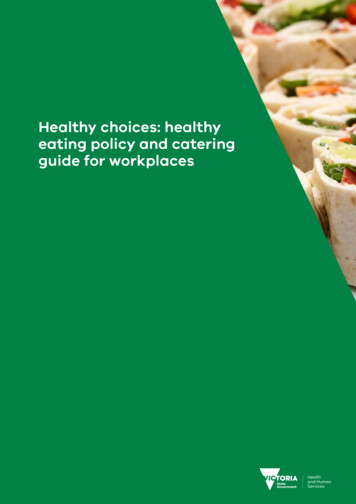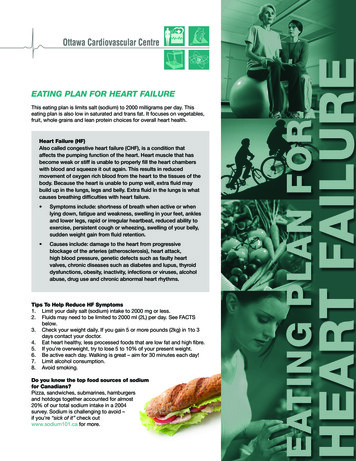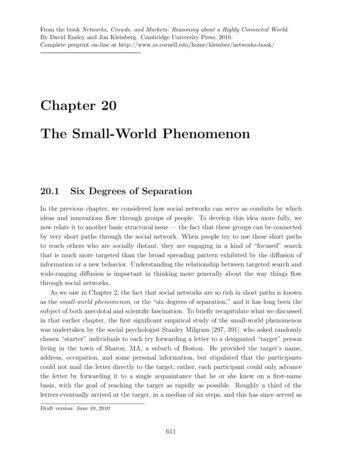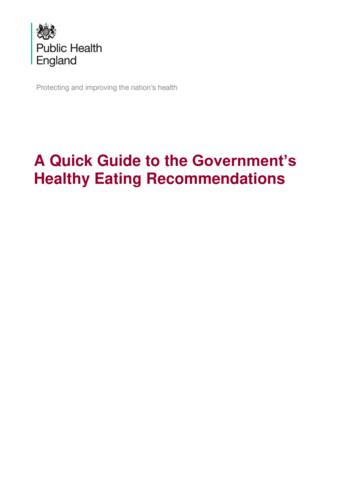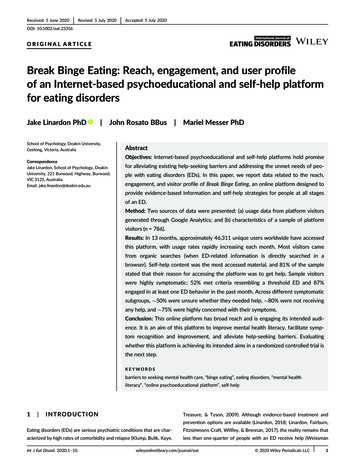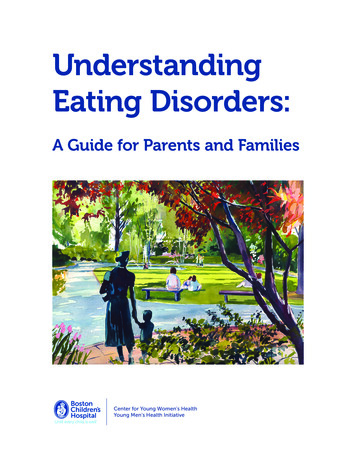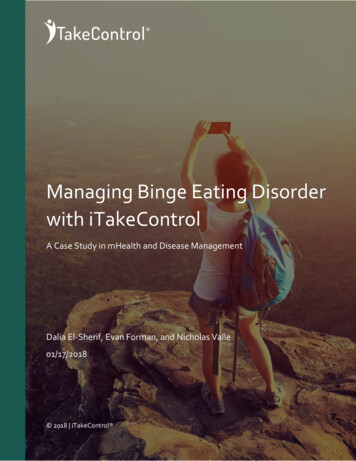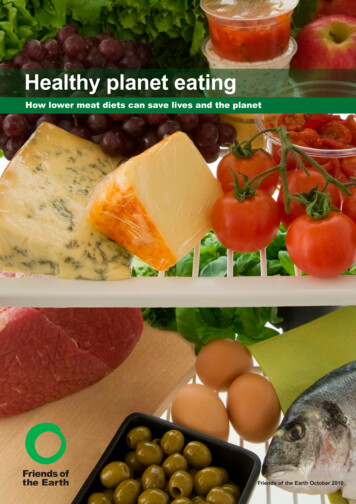
Transcription
Healthy planet eatingHow lower meat diets can save lives and the planetistockFriends of the Earth October 20101
CONTENTSExecutive summary3About this researchintroduction4HOW MEAT CONSUMPTION HAS RISENOVER THE LAST 50 YEARS6Having investigated the environmentalimplications of a range of dietary optionsin 2009’s Eating the planet? report,Friends of the Earth commissionedOxford University’s British HeartFoundation Health Promotion ResearchGroup to analyse their likely impact on: specific health conditions mortality figures NHS expenditureDefining 'meat' 7the health impacts ofexcess meat consumption 8How would reducing meat consumption improve health?8Cancer 10Heart disease and stroke12Obesity 13Premature death 14ALL MEAT IS NOT THE SAME15calls for change 17Tracking what we eatWe eat what we are told1819HOW MUCH IS ‘LESS’ MEAT?20NUTRIENT INTAKE 21Nutrient 21Protein 22Iron 23Children 24The elderly 24Low income groups25RECOMMENDATIONS FOR A HEALTHIER BALANCE26REFERENCES 27AcknowledgementsThe meat and dairy content of the dietsinvestigated ranged from the high meatdiets most common in western countriesto a lower level of meat and dairyconsumption that could be producedwithout eating into the planet’s naturalresources, while allowing consumptiongrowth to sustainable levels in developingcountries.This report summarises the keyfindings of this analysis and presentsa comprehensive literature reviewof existing studies on the healthand environmental impact of meatconsumption.It concludes with a series ofrecommendations for healthy andsustainable diets and the policy shiftsneeded to drive changes.Friends of the Earth October 2010Research by Patricia Thomas. Modeling by Mike Rayner, Dushy Clarke andPete Scarborough, British Heart Foundation Health Promotion ResearchGroup, Department of Public Health, University of Oxford.The key findings of this report are based on research by Oxford University: Modellingthe impacts of the Fair Less Meat diet. This research, including the modelling andmethodology, is available at eports2
Executive summaryWe are producing and consumingincreasing quantities of meat and dairy.This is taking its toll on the planet and onour health – and very little is being doneto tackle it.The livestock industry is one of themost significant causes of globalenvironmental damage – generatinga fifth of the world’s greenhouse gasemissions. The UK’s reliance on importedprotein crops is also driving deforestationin South America. This is having adevastating impact on the people who’velived on the land for centuries.Friends of the Earth and Compassion inWorld Farming’s 2009 research Eatingthe Planet? showed that a move to lowermeat diets in the West would help protectnatural resources and enable us to moveaway from factory farms and damagingintensive crop production.1 It would alsoallow for fair global food distribution andnutritious diets for people in developingcountries.This new research reveals how this dietcould deliver a fairer deal for people,animals and the planet and analyses itslikely impact on the health of people inthe UK. It also reviews existing evidenceon the relationship between meat anddairy consumption and health. It outlinesthe action needed to transform the UK’sfood and farming sector into one thatwould work for people and the planet.Key findingsOver the last 50 years the quantity ofmeat produced around the world hasquadrupled while the global populationhas doubled.We could prevent 45,000 early deathsand save the NHS 1.2 billion each yearif we switched to diets that contain lessmeat in the UK.Lower-meat diets could cut deaths fromheart disease by 31,000, deaths fromcancer by 9,000 and deaths from strokesby 5,000 each year.There is clear evidence of a link betweenhigh meat diets and a higher incidenceof bowel cancer and heart disease withsome evidence of a link between highmeat diets and other cancers, diabetesand obesity.Processed meat is more damaging tohealth than unprocessed meats.Grass-fed beef has nutritionaladvantages over grain-fed options.The nutritional value of some meat hasdecreased as a result of modern farmingmethods. A standard supermarketchicken now contains significantly lessprotein and more than twice as much fatas in 1970.Clear standards should be introduced toensure that meals paid for by taxpayersin schools, hospitals and care homesreflect environmental and health factorsand reduce reliance on meat and dairy inmenus.The Government should shift supportfrom factory farming to the productionof better-quality meat and a healthieroverall food production balance.Grass-fed meat and dairy products arehealthier and more planet-friendly thanfactory farmed options. They shouldbe clearly labelled for consumers. Thiswould help people make more informedfood choices and stimulate the market forthese products.Friends of the Earth is calling on theGovernment to implement these changeswithin the framework of a SustainableLivestock Strategy.Key recommendationsThere is an undeniable need forwidespread adoption of healthier andmore sustainable diets and moreresearch is urgently needed to identifythe best mechanisms for change.Existing healthy eating andenvironmental behaviour guidelinesshould be modified to include the benefitsof eating less meat.3
introductionMeat and dairy products form thecentrepiece of most meals in the UK.Factory-style production and heavysubsidies have made them plentiful andcheap in Europe and America.Our increasing consumption – of meatin particular – is prompting concern overthe impacts on people’s health and onthe environment. But calls for changes todiets and farming methods have tendedto produce a polarised and often illinformed debate.This report aims to throw fresh light onthe stalemate. It does so by presentingevidence on the health benefits ofswitching to lower-meat diets.A cultural challengeThere is little doubt about the science.In the West we eat far more meat thanis necessary or healthy. Health expertssay this is contributing to rising levels ofchronic diseases such as coronary heartdisease, cancers and strokes.Such findings have led to calls fornutritional advice to be revised toencourage a reduction in total meatintake and discourage meat and dairythat is high in fat – particularly saturatedfat – and salt. Instead, small amounts ofbetter-quality fresh lean meat would berecommended.2Yet such thinking is not reflected in anyUK Government guidelines or advice onhealthy eating. Changing our conceptof an average healthy diet is proving achallenge.In the UK there tends to be an allor-nothing approach to meat eating,with little recognition or understandingof the concept of a low-meat diet. It’stelling that, while people who eat nomeat are identified and identifiable – asvegetarians – there is no commonlyaccepted term for people who eat meatonly a few times a week.Attempts to raise awareness of thebenefits of lower-meat diets and tochange diets have proved controversial.4In the media the issue has been oversimplified and distorted.For example, in October 2009 climatechange expert Lord Stern observed thatthe environmental impact of a meat dietwas higher than that of a vegetarian diet.His comment was interpreted in reportsas “people will need to turn vegetarian ifthe world is to conquer climate change”.3Similarly, in January 2009 a plan toreduce the amount of meat servedin hospitals to healthier and moresustainable levels was included in anNHS carbon reduction strategy.4 Theproposal focussed on reducing meat,rather than cutting it out entirely, andsourcing local produce, but was reportedas a “removal” and a “ban” on meat andwas criticised in the media.5 The plan wassubsequently scrapped.Ironically, we are more prepared thanever to throw meat away6. Historicallyregarded as an indicator of affluenceand, for many, a treat, meat is nowartificially cheap and plentiful. Thegrowing quantities wasted suggest that,along with other food groups, meat hasbecome a throwaway commodity.So our attitudes towards meat arecomplex. What is clear is the damagethat increasing consumption is doing tothe environment and people.Environmental and social damageMeat and dairy production – nowresponsible for a fifth of globalgreenhouse gas emissions – is predictedto double by 2050.7 This is incompatiblewith the need to cut emissions by at least80 per cent in the same period to preventthe worst effects of climate change. 8UK factory farms are also drivingdeforestation and ruining lives overseas.Vast areas of forest and wildlife in SouthAmerica are being cleared to grow theprotein needed to quickly bulk up millionsof animals each year. This is forcing localpeople off their lands and into hungerand poverty.
istock Martino/PanosEduardoCattle farm in the Brazilian AmazonAn alternativeThere is already evidence thatconsuming less meat would be good forthe environment and would help feed agrowing population.In 2009 Friends of the Earth andCompassion in World Farming publishedEating the planet?, a groundbreakingreport which demonstrated that we canfeed a growing global population withoutdestroying the world’s natural resourcesor relying on factory farms – and we don’tneed to give up meat.The modelling in Eating the Planet?showed that by adjusting our diets wecould feed a global population predictedto be 9 billion by 2050. Rearing animalsfor food uses far more land, energy andwater than growing crops to providepeople with the same number of calories.A diet containing no more than threeportions of meat each week would takepressure off the land and the climate.The diet outlined in Eating the Planet?would mean a significant reduction inmeat eating in the West, yet it wouldallow for more meat to be eaten indeveloping countries where there arehigh levels of malnutrition. There areas many obese people in the Westas there are malnourished people inpoorer countries: the health and justicearguments for changes to food productionand distribution are as compelling as theenvironmental imperatives.This report adds to the evidence bypresenting modelling on the impact of alower-meat diet on people’s health andNHS budgets. It also reviews: evidence of the health impacts of highmeat and dairy consumption the difference between good and badmeat examples of healthy alternative eatingadvice and plans.Eating less meat is not a silver bulletthat will deliver healthy eating andliving. But a growing body of evidenceshows that we should get the majorityof our nutrients from fresh fruits andvegetables, whole grains and pulses,with only small amounts of meat, dairyand fish as additional sources of protein.Recommendations on fish consumptionwhen stocks are under threat are beyondthe scope of this report but are coveredby Greenpeace and Sustain.9 10Such a diet has many benefitsincluding: reducing the livestock industry’senvironmental impact – including onclimate change improving the health and wellbeing ofpeople in the UK, and indeed the rest ofthe world reducing the burden of diet-relateddisease on the NHS helping to create a thriving and planetfriendly UK farming sector.This report sets out what theGovernment needs to do to encouragehealthy and sustainable diets and foodproduction.Grasping these opportunities wouldtransform the UK into a model forhealthy, sustainable food production andconsumption that, if adopted by the restof the world, would help ensure a fairshare of the world’s food resources foreveryone.5
HOW MEAT CONSUMPTION HAS RISEN OVERTHE LAST 50 YEARSOver the last fifty years there has been adramatic rise in global meat consumptionwith the growth in the global livestockpopulation far outstripping that of thehuman population.Between 1961 and 2008 the worldpopulation increased by a factor of 2.2,11but total meat consumption quadrupled– from 71 million tonnes to 280 milliontonnes – and poultry consumptionincreased 10-fold – from 9 million tonnesto 91 million tonnes.12According to the most recent data onmeat eaten per person – from 2002 – theUnited States leads the developed worldin meat consumption with each Americaneating an average 125 kg of meat a year.Per capita meat consumption in Europeaveraged 74 kg, while the average UKcitizen consumed 80 kg13 – equivalent to1,400 pork sausages each year, or nearlyfour a day.Demand is also growing in somedeveloping countries as a result ofrising incomes and a growing urbanmiddle class,14 although it is still wellbelow European and US levels. Meatconsumption in China, for example, hasgone from an average of 20 kg per capitain 1980 to 52 kg in 2008.15 Although inIndia meat consumption has grown by 40per cent in the 15 years to 2007, it is still40 times less than average consumptionin the UK.Between 1961 and 2008 theconsumption of dairy products hasdoubled – from 344 million tonnes to693 million tonnes.16 Dairy products area good source of protein and a majorsource of calcium in the West. Dairycan also be high in fat and saturated fat.However in response to public healthcampaigns to encourage lower totalfat and saturated fat in the daily diet,there has been a substantial switch toconsuming more low-fat products overthe last 20 years.The abundance of meat and dairy inour diets is seen as an indication of ourincreasing affluence and as a triumphof the modern animal husbandry andlivestock farming practices. Thesedevelopments allow us to producestaggering amounts of meat and milkon relatively small parcels of land, and,because animal foods are rich in protein,as a boon to human health.But the World Health Organization(WHO) is among many organisationsto suggest that in the West we nowconsume considerably more proteinthan is considered necessary or optimalfor health.17 At the same time it is clearthat the population explosion in livestockhas not eased world hunger. In fact,with nearly a billion people starving, aquestion mark hangs over how rational,or ethical, it is to feed such a largeproportion of edible grains and proteinsto animals.It is only recently that we have begunto quantify the human health andenvironmental consequences of thisexponential growth in livestock productionand consumption. The Friends of theistock6
Earth reports Eating the Planet?18 andWhat’s Feeding Our Food?19 showthat these burdens are both increasingand unsustainable and there are nownumerous pressing reasons for adoptinga lower-meat diet.Compared to growing crops for directconsumption, rearing animals for fooduses large areas of agricultural land,vast quantities of water and significantamounts of energy. It is a cause ofdeforestation and land use change,generating greenhouse gas emissionsand destroying valuable carbon sinks andwildlife habitat. The livestock industryis also a significant drain on energyresources: growing grain for livestockrequires large energy inputs in termsof fertilisers and pesticides. It is also asignificant source of pollution.20The economic burden of animal foodconsumption is also high because ofthe large amounts of grain that needto be grown to feed farmed animals.21One kilogram of intensively-reared beefrequires up to 10 kg of animal feed.22The global spread of intensive farminghas led to a major increase in thediversion of cereals and other grainsaway from the human food chain and intoanimal production. For instance, today97 per cent of the soymeal and 40 percent of cereals produced worldwide areused for animal feed.Animals’ feeding requirements meanthat livestock uses 70 per cent of allavailable agricultural land, and uses 8 percent of the global human water supply.23With growth in demand for livestockproducts set to continue, more land andmore water – and more food that couldbe consumed directly by humans – isbeing turned over to feeding livestock,further exacerbating the associatedimpacts.Because of all these inputs, thecontribution of animal farming to theproduction of greenhouse gases andclimate change is substantial. TheUnited Nations Food and AgricultureOrganization (FAO) estimates it isresponsible for 18 per cent of globalgreenhouse gas emissions – including9 per cent of man-made global carbondioxide (CO2) emissions and 37 per centof anthropogenic methane.24These are excesses – in pollutionand resource use – that the worldcannot support over the long term. Butenvironmental excesses are not the onlyimpact of rising livestock consumption.Studies into human health arebeginning to show that, in the same waythat excess fat and excess sugar in thediet can be detrimental to health, excessmeat consumption can have profoundlynegative consequences for our healthincluding higher rates of heart disease,stroke, cancer, and premature death.At the same time it is becoming clearthat all meats are not the same in termsof their impact on health. As the sciencehas become more sophisticated andbegun to differentiate between freshmeat and that which is preserved orhighly processed, data now shows thatthe greatest negative impact on healthcomes from consumption of the latter.‘bad’) fats and carbohydrates and thisknowledge has been incorporated intohealthy eating guidelines.Just as there are ‘good’ and ‘bad’fats and carbohydrates it is increasinglybecoming acknowledged that there arealso ‘good’ and ‘bad’ meats.In very early studies of meat intakelittle distinction was made betweendifferent types of meat, indeed ‘meat’has no common definition in scientificresearch. More recent studies,however, have begun to make importantdistinctions between fresh and preserved/processed meats and between red andwhite meats.In general, the term ‘red meat’ refers tobeef, lamb and pork; as a broad categoryit includes both fresh and processed/preserved meats. ‘White meat’ is less welldefined but in scientific research usuallyrefers to poultry and sometimes fish.In the scientific literature and in thisreport, processed and preserved meatare defined as any meat preserved bysmoking, curing or salting, or with theaddition of chemical preservatives, forexample bacon, salami, sausages, hotdogs or processed deli or luncheonmeats (including some white meats suchas turkey and turkey ham). This type ofmeat often contains a number of harmfulsubstances including heterocyclic amines,polycyclic aromatic hydrocarbons,29 andN-nitroso compounds30 formed in thehigh temperature cooking of meat. Thenitrate and nitrite preservatives addedto processed meats are also knownprecursors to N-nitroso compounds (seeAll Meat is not the same, page 15).Defining 'meat'In terms of sheer volume of raw materialsand goods, modern farmers and foodproducers are highly productive. Humanbeings have made substantial gainsin health and longevity thanks to thisproductivity.25 However this abundancehas not benefitted mankind universally– 925 million people worldwide areundernourished due to lack of access togood food in sufficient quantities.26In addition, much of the abundancewe enjoy is in the form of high fat, highsugar foods which are energy intensive toproduce27 and also damaging to health.28Rising rates of obesity and chronicdiet-related diseases suggest that in themidst of this abundance means we have‘forgotten’ how to discriminate. Scienceis helping us to relearn this skill. Wenow understand the difference betweenhealthy and unhealthy (or ‘good’ and7
new researchTHE HEALTH IMPACTS OF EXCESS MEAT CONSUMPTIONThe health effects of reduced meatconsumption are becomming wellestablished in the scientific literature. Asthe study populations themselves havebecome larger and as the methodologyof such studies has become moresophisticated, the weight of the evidencehas grown. A valuable picture hasemerged of how the balance of meat anddairy and other foods in our diets can actto improve or harm health.Much of the early data on diet,lifestyle and health came from studyingvegetarian lifestyles. Other data comesfrom long term observational studieswhich look at what people eat and whatdiseases they develop over time.Still more comes from interventionstudies where people who are sufferingfrom a chronic illness or who are at highrisk of illness are switched to more plantbased diets.Such data highlights the healthproperties of a diet high in fruits,vegetables, unrefined grains andpulses and moderate amounts of meatequivalents such as soy. Studies showthat those who eat little or no meat anddairy are often healthier than the generalpopulation.31However, it is a mistake to place toonarrow an interpretation on these studies.There is firstly a tendency, particularlyin older studies, to group all vegetariansand vegans together even though thereare important differences in nutrientintake between a strict vegan diet, a strictvegetarian diet, a lacto-ovo-vegetariandiet (which allows milk and eggs) and alacto-ovo-pesce vegetarian diet (whichallows dairy, eggs and fish). In additionto eating few or no animal products,vegetarians and vegans also tend topractice other healthy activities thatcontribute to their overall level of health,including taking more exercise andsmoking less.8Yet studies show that excess meat ingeneral, and preserved and processedmeats in particular, can add high amountsof fat, saturated fat and salt to the diet.The most important health impacts ofexcess fat and sodium include increasedrisk of heart disease, stroke and cancer,as well as an increased incidence ofobesity and premature death.In contrast, diets where plant-basedelements dominate are associated withlower body weight,32 greater longevity33and a lower rate of certain chronicdiseases especially diabetes, heartdisease, and some cancers.34The cost to the NHS of diet-relatedillness is estimated to be twice that of car,train and other accidents and more thandouble that of smoking.35 Diet-relatedillnesses, however, can be prevented.It has been estimated that the NHScould save around 6 billion a year ifthe excesses and inadequacies in ourcurrent diets could be addressed in thesame proactive way adopted to addressthe health impacts of smoking. Newmodelling carried out by Friends of theEarth shows that widespread adoptionof lower-meat diets could prevent 45,000deaths and save the NHS 1.2 billioneach year – see graph 1B.This requires strong, clear,unambiguous guidance from health andfood policy makers. As the data on theharmful effects of consumption of excessmeat continues to amass, the casebecomes stronger for a thorough reevaluation of healthy eating guidelines.How would reducing meat consumptionimprove health?New research carried out by OxfordUniversity’s British Heart FoundationHealth Promotion Research Group forFriends of the Earth used the DIETRONmodelling system to analyse the healthimplications of a range of diet scenarios.36It concluded that switching from currentdiets to a diet that contains two or threemeat meals each week and a smallamount of dairy each day would prevent45,361 deaths each year (see graph).Table 1: Change in cost to the2006/07 NHS budget (baseline 2007 UK diet)Disease CurrentLessFair Lessdiet trends Meat MeatCHD 0.05bn- 0.57bn- 0.80bnStroke 0.00bn- 0.07bn- 0.10bnCancer 0.02bn- 0.20bn- 0.30bnTotal 0.07bn- 0.85bn- 1.20bnA note on the dietsThese diet scenarios are based on Friends of the Earth and Compassion in World Farming’s2009 report Eating the planet? which analysed different diet options and farming methods toassess their impact on global food production and the feasibility of feeding the estimatedpopulation in 2050 – nine billion.‘Current diet trends’ reflects the level of meat and dairy that will be eaten in the UK iftrends around increasing consumption are projected into the future.‘Less meat’ is based on satisfying growing food and nutritional demands with a lower meatdiet with 30 per cent of protein from animal products.‘Fair less meat’ assumed a fair distribution of nutritionally sufficient diet that allows for meat2 or 3 times each week and some dairy each day.In place of the contribution of meat and dairy, the ‘Less Meat’ and ‘Fair Less Meat’ diets includemore fruit and vegetables, and an increase in the amount of starchy carbohydrates. Thesechanges, in combination with a reduction in saturated fat from meat and dairy and a reductionin salt from processed meats, are responsible for the predicted changes in health outcomesdisplayed in graph 1b and table 1. With a reduction in food waste and more fair food distributionand diets, this scenario would feed the world and allow for planet-friendly farming methods.37
Graph 1B: Change in annual mortality by cause(baseline 2008 average UK diet)45,361Current diet trendsLess MeatFair Less Meat32,35231,09422,149lives 1,07750Total deathsCHDStroke202increasein Deaths2509Total cancer491MLP cancer102Oesoph. cancer292464379Stomach cancerLung cancer14718179
how meat consumption affects healthCancerThe relationship between diet and cancerhas become increasingly clear over thelast few decades. Cancer is responsiblefor 7.4 million deaths globally eachyear, about 13 per cent of all deaths.38The WHO estimates that 30 per centof cancers in the developed world (and20 per cent in developing countries) arecaused by dietary factors. In the UK itis estimated that 26 per cent of cancerscould be prevented by altering diet.39Colorectal cancerThe relationship between diet andcancer is particularly strong for colorectal(bowel) cancer. In 2005 a Europeanstudy involving more than a half a millionpeople found that, amongst people whoregularly ate more than two portions ofred and processed meat a day, the risk ofdeveloping bowel cancer was 35 per centhigher than for those who ate less thanone portion a week.40The conclusions of this study arein line with the results of three metaanalyses,41 42 43 which show a 20-30 percent increased risk of bowel cancer inthose eating 100-120 g/day of red meatand up to 50 per cent increased risk ofbowel cancer in those eating 25-30 g/dayof processed meat.The broadest and most authoritativereport on the link between meat andbowel cancer, however, comes fromthe World Cancer Research Fund(WCRF) which, over the last decade,has forensically reviewed all theavailable studies to date on the possiblerelationships between meat and dairyintake and cancer.44The WCRF report found convincingevidence that eating more than 500 g ofred meat each week significantly raisedthe risk of bowel cancer. In particulareating 150 g of processed meat a day(equivalent to three sausages or threerashers of bacon) increases the risk10of developing bowel cancer by 63 percent. The report went on to recommendlimiting overall consumption of red meatto between 300 g (11 oz) - 500 g (18 oz)a week – equivalent to around 2 ouncesdaily – very little if any of which shouldbe processed meat. This compares tothe current UK level of consumptionof around 190 g (6.6 oz) each day,according to the latest National Diet andNurition Survey.45How meat intake causes cancer isstill not completely understood. Thereis, for example, no strong associationbetween high fat intake and bowelcancer risk independent of meat intake.46One Swedish study, for instance, foundthat women consuming the highestamounts of full-fat dairy productshad a significantly lower risk of bowelcancer,47 and a randomised trial foundthat switching to a low-fat diet offeredno significant protection against thedisease.48Instead it has been suggested thatthe contaminants and additives suchas nitrates in processed meat may beinfluential (see page 15).The heme iron component of red meat(see page 23) is also associated withthe generation of free radicals, highlyreactive molecules that can cause thekind of cellular damage and mutationsknown to influence cancer and otherdiseases.Any or all of these mechanisms maycome into play, and even though themechanisms are not fully understood,the strength of the evidence was suchthat the WCRF recommendation to limitred meat was quickly incorporated intoUK Department of Health guidelines, aswell as being recommended in a recentCabinet Office report on food policy.49Although the evidence is strongest forcolorectal cancer, other cancers have alsobeen associated with high-meat diets.Breast CancerA 2006 study which followed more than90,000 premenopausal women for 12years50 found that, compared with thosewho eat three or fewer servings per week,women eating three to five servings of redmeat weekly have a 14 per cent higher riskof a hormone-dependant breast cancer,while those eating more than five servingsa week have a 42 per cent increased risk.Two of the largest studies so far,the pan-European EPIC study51 whichfollowed more than 300,000 women andthe US AARP Diet and Health study52which followed more than 188,000 women,have also found that that those whoeat the most saturated fat have a smallincreased risk of breast cancer.There are several ways in which meatintake could affect breast cancer rates.Some observers suggest it is the resultof increased fat intake from red meat anddairy.53 It has also been suggested thathigh dietary fat intake may increasingcirculating levels of oestrogen and otherhormones.54 The association betweendietary fat and breast cancer, however,remains controversial55 and not all studiesshow a link.56Stomach and Bladder CancerSome,57 but not all,58 data links meat intakewith bladder and stomach cancer andthis, research suggests, may be relatedless to fat and more to the additives andcontaminants in many red meat products.In a 2010 study of over 300,000 menand women, those whose diets had thehighest amount of total dietary nitrite (fromall sources including meat), as well asthose whose diets had the highest amountof nitrate plus nitrite from processedmeats, had a 29 per cent increased risk ofdeveloping bladder cancer.59 (For more onadditives in processed meat see page 15).
Dairy and cancerLinks between dairy products and cancerare less conclusive. The WCRF foundthat data for the relationships betweenmilk and dairy products and cancer waseither “too sparse, too i
Friends of the Earth October 2010 How lower meat diets can save lives and the planet Healthy planet eating istock. 2 ExEcutiv 3E summary intrOducti O4n . This new research reveals how this diet could deliver a fairer deal for people, animals and the planet and analyses its likely impact on the health of people in the UK. It also reviews .

